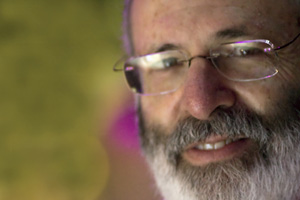UCSF Adopts New Information Technology Governance Structure

Elazar Harel
With an eye toward improving Information Technology Services at UCSF, the University is adopting a new governance model to steer its growth and development in a strategic and coordinated manner.
Spearheading various short- and long-term IT improvements, including governance, is UCSF Vice Chancellor Elazar Harel, PhD, JD, who is chief information officer and a longtime expert in the field.
Harel, who came to UCSF in March, has been extremely busy addressing the University’s information technology infrastructure and looking for ways to streamline and improve services across administrative and academic areas.
“We are doing whatever makes sense – to eliminate as many obstacles, barriers and bureaucracies – to make people’s lives easier and to enable each one of us to do our jobs as well as we can,” he says.
In fact, Harel has already made considerable progress doing exactly that. One noticeable difference is reverting back to Information Technology Services (ITS) instead of OAAIS, a name that few understood to mean IT.
Under Harel’s direction, UCSF has relieved many IT users from daily frustrations, including:
- Ending automatic password expiration;
- Ensuring that outgoing UCSF phone caller ID is no longer blocked;
- Enhancing cellular voice and data coverage on the Parnassus campus;
- Providing full Virtual Private Network support to the UCSF campus community for the iPad, iPhone, and iPod Touch devices.
New Governing Model
Harel, who previously served in IT leadership posts at UC San Diego and UCLA, will be part of the newly formed IT Steering Committee, which is the central, advisory body made up of top campus and medical center leaders.
The steering committee, chaired by Clay Johnston, PhD, director of the Clinical and Translational Science Institute (CTSI), oversees four subcommittees that will be responsible for areas, such as education, research, business, and IT architecture & support. Each of those four subcommittees will have working groups that will focus on specific initiatives.
For example, the education subcommittee, to be chaired by Joseph Castro, PhD, vice provost rof Student Academic Affairs, will have two working groups, one focusing on classroom and online learning and another one on student support. It is important that UCSF get up to speed with online learning, which has made leaps and bounds in the digital age at other UC campuses and elsewhere.
“The goal is to move away from operating in silos and making decisions and investments ad hoc and without looking at the whole picture,” Harel says. “This governance structure will let us make decisions, set IT priorities, identify IT funding needs and institute IT policies in a coordinated manner.”
Indeed, the steering committee, which will begin meeting in December, serves as advisors to Executive Vice Chancellor and Provost Jeff Bluestone, PhD, and Senior Vice Chancellor John Plotts, both of whom are members of the steering committee.
UCSF Medical Center leadership is also well represented on the steering committee with Mark Laret, chief executive officer, and Larry Lotenero, chief information officer, both serving as members. The medical center will retain its own steering committee chaired by John Roberts.
The IT governance structure fits well with the ongoing efforts to achieve “operational excellence,” a process which seeks to reduce expenses, redundancies and inefficiencies and improve productivity across the University.
Importantly, the UCSF School of Medicine, by far the largest school in terms of human and financial resources at UCSF, is involved in IT initiatives with Opinder Bawa serving as chair of the IT architecture and support subcommittee. Bawa now spends half of his time working for the school and other half working for ITS, a move that has improved communication and coordination for IT customers.
The University also will engage the IT expertise of representatives from throughout industry, academia and governmental agencies through a new external advisory board. The members of this board have not yet been named.
One of the many challenges for UCSF, as identified in its 2007 strategic plan, is developing new mechanisms to fund needed improvements in infrastructure, including ongoing maintenance and operating costs for IT. The UCSF Strategic Plan specifically called on the University to support “a broader and more integrated IT governance process, and provide sufficient funding to acquire new technology and to support and operate the technology once in place.”
The new governance structure will certainly help UCSF identify how best to invest in the future, Harel says. “We need to come up with a better funding model for IT that is sustainable and that is fair.”
While the expenses loom large, costs can be reduced by creating partnerships and consolidating functions across the University, which employs about 800 IT personnel many of whom are working in their own distinct areas with systems that often are not compatible.
“We are looking at ways to optimize email, help desks, IT procurement, desktop support, data centers,” Harel says.
UCSF can save money and time if it had an easy way to streamline and simplify the IT procurement process, Harel says. UCSF can leverage its considerable buying power by negotiating new contracts with top vendors, such as AT&T, Cisco, Dell and Apple. Harel believes that UCSF can recommend a few standard IT configurations that allow campus and medical center customers to buy compatible systems at the best prices. These optional packages can come pre-loaded with UCSF-recommended encryption and software that its IT workforce is trained to maintain.
“We need to be flexible and fluid,” says Harel, who will be part of every group in the new governance model. “I need to be involved so that I can fully understand what we need to do and to help see that we get it done.”
Harel is also looking to form partnerships with other campuses, including UC Berkeley, where his counterpart, Shelton Waggener, is eager to optimize IT to the benefit of both sister institutions.
Related Links:
Seasoned IT Expert to Join UCSF as Chief Information Officer
UCSF Today, March 29, 2010